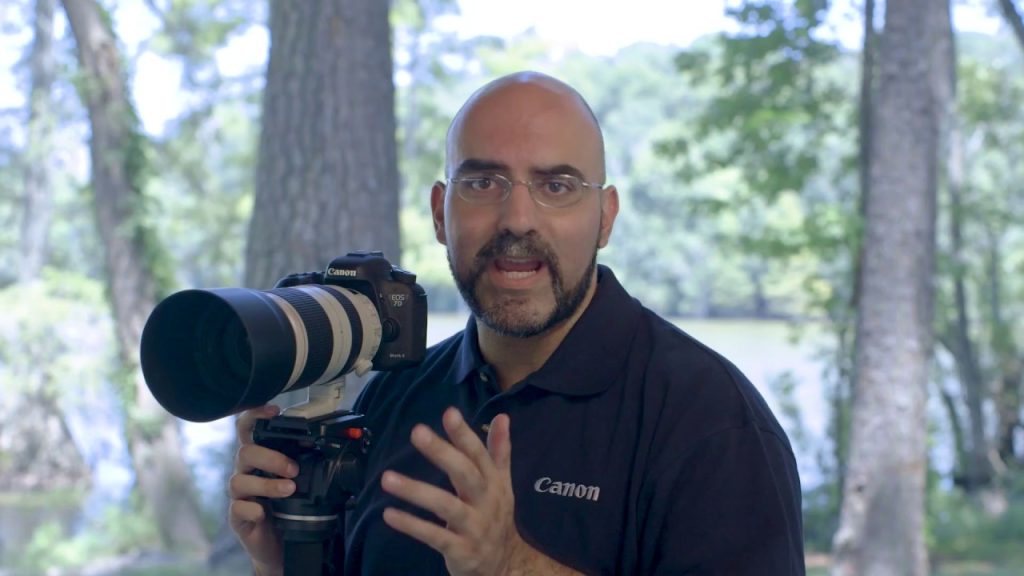[Music] Hi. My name is Danny and I'm a Canon
Technical Support Representative. Birds in flight can be one of the most
challenging subjects to photograph. In this video, you'll gain a basic
understanding of how to set up the Canon EOS 7D Mark II digital SLR camera to
capture birds in flight. Even with the best camera and lens, it can be difficult
to get photos that are in focus 100% of the time. With this video, we hope to
increase that success rate. Let's start with the camera settings. First, I recommend using TV mode or shutter priority to make sure you have a fast
enough shutter speed. Evaluative metering usually does a great job occasionally
for a light-colored bird against a dark background, spot metering will work best.
Use an ISO setting that you're comfortable with.
I personally use ISO
200 most of the time but with current camera technology you can go much higher
and still get great pictures with minimal noise. Setting up an auto ISO range can also facilitate quick automatic ISO setting changes. I also
recommend a shutter speed of at least 1/2000 to make sure you're freezing the action in your frame. Next, the auto focus mode should be set to AI servo. Press the Drive AF button and turn the main dial to select AI Servo. Pressing the shutter
button halfway will auto focus. You can also use the back button focusing method
to take away auto focus from the shutter button. To do this go to the Custom
Controls menu, then go to the display and operations section. Select custom
controls and press the Set button.
Select the shutter button icon, and press Set. Then select Metering Start to remove auto focus from the shutter button. Now
only the AF-ON button will trigger auto focus. Just hold the AF-ON button to keep
your subject in focus. Your shutter button is free to take the shot without
accidentally refocusing on another part of your composition. After setting the
focus mode to AI Servo, let's make sure that the camera is set to continuous
high-speed shooting.
Press the Drive-AF button and then turn the quick
until you see the high-speed shooting icon. Silent continuous shooting is also
an option if you're close to your subject. Now, let's set the AF area
selection mode to Expand AF Area Surround. A quick way to do this is to
press the Info button until the shooting information is displayed on the LCD screen. Then press the AF point select button.
Use the multi-function button labeled M-Fn near the shutter button, or the AF area selection lever around the multi-controller to select the AF mode. Expand AF Area Surround lets you use eight supporting focus points around one
primary focus point.
Now, let's move to the AF configuration tool in the AF menu and pick a case that matches the bird's behavior. Case 1 is the default case
and work well in many situations as long as the bird is at a constant speed. For
birds that are accelerating and decelerating case four is recommended.
For example: ducks taking off and landing. Case 5 is recommended for birds that
quickly change direction. Swallows are a good example. Another setting is Safety
Shift located in the first custom function menu. This setting allows the
camera to automatically change your set shutter speed, aperture, or ISO. The
Shutter Speed/Aperture option will lower your shutter speed when there's not
enough light for good exposure at your chosen shutter speed. The ISO speed
option will increase ISO as needed. There are so much to keep track of
during bird in flight photography and Safety Shift can help ensure accurate
exposure. Once you have your camera set up, I recommend saving the settings as a
Custom Shooting Mode. To do this, go to the wrench menu in the Set Up 4
section and select Custom shooting mode.
Select Register settings and assign your
custom shooting mode to one of the three available options. C1, C2, or C3. Let's say you previously saved your bird
in flight settings to C1. You're photographing a landscape and all of a
sudden you see a bird flying towards you. You can quickly revert to the settings
you saved by turning the mode dial to C1. Now that we have the camera
set up, let's give it a try. As you can see I'm using the canon EOS 7D Mark II
camera with the Canon EF 100-400mm L IS version 2 lens on a monopod.
If you're using a larger lens you might need a sturdier
setup like a tripod and a gimbal head. Make sure that the lens you're using is
set to Auto Focus. If you're on a sturdy tripod you can turn off the Image
Stabilizer. It takes a lot of practice to keep a focus point on a bird in flight.
Using Expand AF Area: Surround helps a lot but again, practice makes perfect. I also recommend
keeping the Sun behind you so your subject is well lit. Once you spot your
bird in flight, keep the center focus point on the bird and press the focus
button to acquire and maintain focus. Press the shutter button to take short
continuous bursts instead of long ones.
High-speed continuous shooting can fill
up your memory card quickly. Check your images occasionally to make sure that everything is properly exposed and in focus. Also this is a good time to make
sure that your settings are still where you want them. These techniques are a
good starting point for bird in flight photography. There are many other ways to
photograph birds depending on the situation. The techniques we covered will
help you develop your own methods for photographing birds. Continue to hone
your skills and create your own style. It takes practice, patience, and perseverance.
For more how-to videos please visit our YouTube channel. Thanks for watching!.


